

Table of contents
- volume
- Size
- depth
- Calculate garden pond volume
- squares and rectangles
- circles
- ellipses or ovals
- pond size and overwintering
A garden pond can enrich the garden for people and animals. However, if goldfish are to be kept in it, it must be of the appropriate size and depth. This is especially true if the fish are supposed to overwinter in it. Because the right dimensions are important for the health and safety of the fish stock.
volume
When it comes to the volume of the garden pond, the bigger the better. And that in several respects. A more stable biological balance can be established in a large garden pond. Impurities such as falling leaves, uneaten food, fish excrement or dead plant matter are therefore less of a problem than in a small pond. Large garden ponds also have other advantages to offer:
fish stock
Goldfish should at least be kept in small groups and will breed if the pond is well cared for. If this is the case, sooner or later the fish stock in a small pond will have to be reduced. With a large volume, this is much less necessary.
predators
Cats, but also herons, foxes and other animals see a potential food source in a garden pond with goldfish. A large volume gives the fish more opportunities to escape from these predators.
layout
A bank area, different plant levels, parts of the garden pond lying in the shade and others from the sun illuminated - a large scope with the appropriate depth is also possible with comprehensive design options along. Several and different plants can be introduced, which in turn serve as food sources and hiding places for the fish. The optics also benefit from this.
cleaning
Since the balance in the water is more stable with a large volume, the garden pond will less often need to be completely cleaned and cleared of accumulated sludge. However, a suitable filter is still an important prerequisite. As well as the regular removal of accumulated dirt.
wintering
Small, shallow ponds can freeze over despite proper precautions. In this case, the goldfish must be caught in the fall and overwintered indoors. In a garden pond with a large volume, not only is there less effort involved in overwintering, it is also safer for the fish.
Size
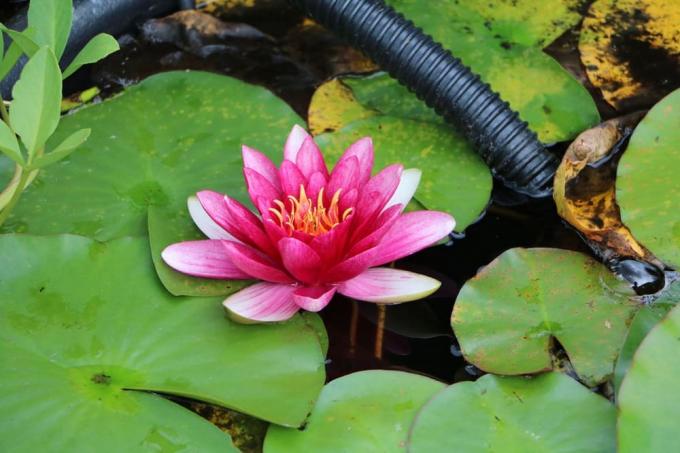
There is a simple rule of thumb for choosing the size of a garden pond for goldfish: At least three liters of water should be planned for every centimeter of length of a goldfish. With five goldfish, each ten centimeters long, that would be:
- 5 fish x 10 centimeters per fish = 50 centimeters of fish length
- 50 x 3 liters = 150 liters
However, what is not considered is the growth of the fish or their final size, any reproduction and the volume of water that is used by plants. Therefore, the following factors should be taken into account when making the calculation:
- the first 1,000 liters should be aquatic plants
- Goldfish can be 35 centimeters long depending on the breed
- Goldfish spawn contains 500 to 3000 eggs
While typically only a small fraction of the eggs manage to be fertilized and hatch, the hatch rate can still be quite high. The size of the garden pond should therefore never only be calculated for the fish that are currently available. It is better to plan for the final size of the fish and a reserve for plants and offspring. Other aquatic life such as frogs, tadpoles and newts should also be included. Because these also drop feces and consume the oxygen contained in the water.
The rough calculation could look like this:
- 5 fish x 35 centimeters length = 175 centimeters fish length
- 175 x 3 liters per centimeter = 525 liters
525 liters for the current fish stock
+ 1,000 liters for aquatic plants
+ 1,000 liters for any offspring and other aquatic life
= 2,525 liters
That sounds like a very large pond and the reserves are already generously calculated. In fact, with a round pond shape, a diameter and a depth of 1.5 meters each would be sufficient to achieve this volume of water. The advantage of this generous calculation and the planned reserves is, in turn, that The balance of the water is more stable and thus the cleaning effort is reduced - but the safety is increased.
depth
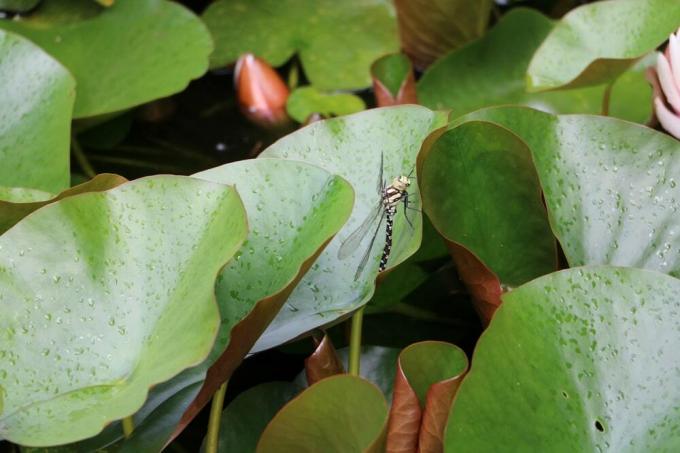
In addition to the circumference, radius or diameter, the depth naturally also plays a decisive role in the size of the pond. On the one hand, it affects the water volume. On the other hand, a greater depth offers better retreat possibilities for the goldfish and thus protection from enemies. It also makes it easier for the fish to overwinter. The absolute minimum depth for goldfish is 80 centimeters. In summer there are still cooler water areas in the depths. In winter, the garden pond cannot freeze completely. However, a depth of 1.0 to 1.5 meters is better. In a garden pond, such a depth means:
- no complete freezing even in cold winters
- more stable temperatures throughout the year
- Cleaning and sucking off pond sludge is still easy
- Greater security for the fish from predators such as cats or herons
- Design of different sections and introduction of different plants possible
When creating the garden pond, a greater depth also means more effort. In the long term, however, there is an advantage above all through the safer and easier overwintering of the goldfish. In addition, the fish can move away in summer when the upper water areas become too warm.
Calculate garden pond volume
The bigger, the better – that much is now clear. But how can the water volume in a garden pond be calculated at all? Because if it is not a perfect cuboid shape and the pond possibly also has different shaped sections, the calculation seems difficult to impossible. However, the solution to this is very simple. The entire garden pond is not calculated, but the respective sections.
The surface areas of the respective shapes are first calculated and then multiplied by the depth of the section.
squares and rectangles
For the area of rectangles and squares, only the side lengths are multiplied together.
Example:
Side length a x side length b = area (A)
1 meter x 2 meters = 2 square meters
To calculate the volume from this, the depth is multiplied by the area.
A x depth = volume
2 square meters x 1.5 meters = 3 cubic meters
circles
For the area of a circular shape, the radius or half the diameter is first squared and then multiplied by the number pi.
Radius² x Pi = Area (A)
(0.75m x 0.75m) x 3.14159 = 1.76715 square meters
For the volume of the round section, the area is again multiplied by the volume.
Area (A) x Depth = Volume (V)
1.76715 square meters x 1.5 meters = 2.65072 cubic meters
ellipses or ovals
Elliptical or oval shapes are often chosen for garden ponds. The area is calculated by multiplying half of the axes with each other and with the number pi. In order to calculate the semi-axes, the two side lengths are simply halved.
In a pond two meters long and one meter wide, the long axis (a) measures one meter and the short axis (b) 0.5 meters.
a x b x Pi = area
1 meter x 0.5 meter x 3.14159 = 1.5708 square meters
For the volume, as with the other shapes, this result is multiplied by the depth of the section.
Area (A) x Depth = Volume (V)
1.5708 square meters x 1.5 meters = 2.3562 cubic meters
Finally, the cubic meters only have to be converted into liters. A cubic meter corresponds to 1,000 liters. A volume of three cubic meters therefore holds 3,000 liters.
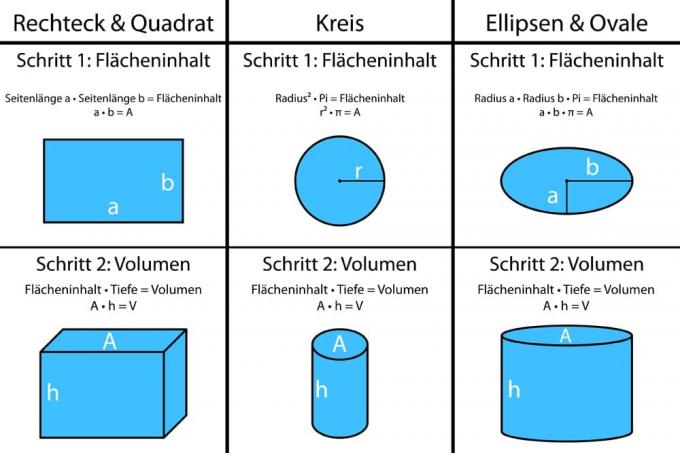
Tip:
However, it should be noted that these are only approximate values, as the pond usually tapers downwards - i.e. narrower. If you want to be sure that there is enough water for the desired number of fish, you should make the side lengths a little larger and the target volume a little higher.
pond size and overwintering
Garden ponds that are as large and deep as possible offer protection during the winter and allow the goldfish to remain outdoors during the cold season. But there is more to this, because it is not only the low temperatures that affect the fish.
The garden pond is usually designed in such a way that it tapers towards the bottom. As a result, the water volume also decreases at depth. If the pond freezes over from above, the goldfish not only have less space and water available, but also less oxygen. This is not a problem in itself, because the slowed down metabolism during the winter also slows down the respiration of the fish.
However, if the number of fish is large, the pond continues to freeze over, or if aquatic plants in the pond consume oxygen instead of producing it, this situation becomes dangerous. In fact, most fish don't freeze to death in ponds, instead they suffocate. In order to reduce this danger, the garden pond should be prevented from completely freezing over – regardless of how large and deep it is. The following measure is recommended for this:
- For small garden ponds, use a thick styrofoam plate or, even better, a special anti-ice agent. For larger ponds, several styrofoam plates or an ice preventer with an air pump should be used.
- If a styrofoam plate is used, a hole should be cut in the middle and a piece of garden hose passed through. The hose should be long enough that it almost reaches the ground but is not stuck in the substrate.
- Weighting may be required to keep the styrofoam from floating too easily on the water and thus lying above the ice. Heavier, larger stones are ideal for this, which are lightly pressed all around into the polystyrene or glued to it. However, special weights can also be used.
Tip:
Styrofoam or ice preventers should already be applied to the pond in autumn to provide protection in the event of any early onset of night frost.
 garden editorial
garden editorial I write about everything that interests me in my garden.
Learn more about creating a pond

Build your own stream out of concrete 6 tips for investing
If you have a natural stream in your garden, you can count yourself lucky. Such an idyllic facility can also be built from concrete. This guide contains tips for building your own.

Laminate pond | 6 tips for working with GRP
Ponds were and are eye-catchers, animation and variety in many garden designs. They are particularly durable when made of plastic reinforced with glass fiber. However, if you want to process GRP yourself, you should know a few helpful tips in order to skilfully avoid recurring errors and problems.
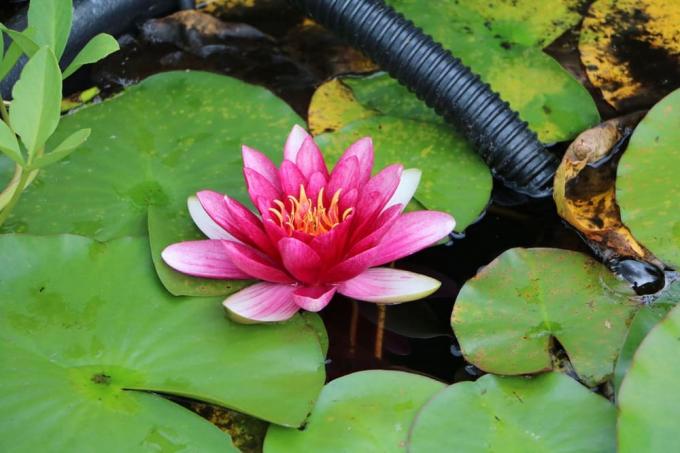
Designing the edge of the pond | 10 ideas for pond borders and pond edge design
If you want to design your pond edge, there are numerous ideas for hiding it. Especially after using pond liner, gardeners rely on a pond border, as this covers the liner and the pond is attractively integrated into the garden.

Build a wooden jetty on the pond yourself - building instructions for a wooden jetty
You have a garden pond and would like to equip it with a jetty? For many it makes sense to leave this project to a professional, but it really is not difficult to build a pond bridge for your garden yourself.

water basin in the garden | An alternative to the pond?
A refreshing highlight in the creative garden design is a magical water world that invites you to linger with its gentle splashing. Creative home gardeners with a penchant for modern solutions rightly ask: are water basins in the garden a sensible alternative to the traditional pond? With practical reflections, this guide would like to help you decide between a water basin or a pond in the garden.
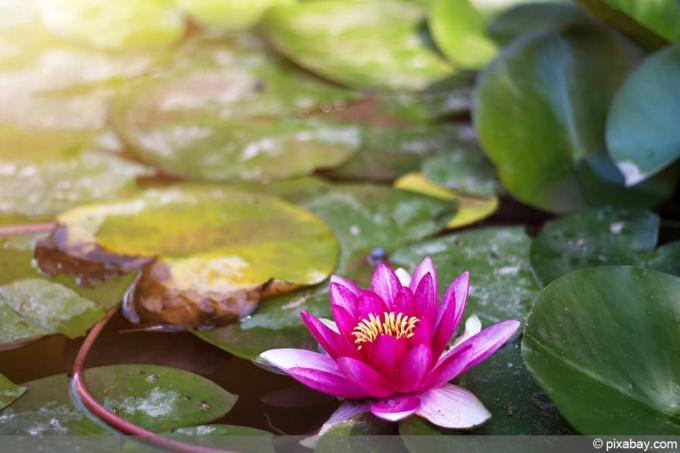
Instructions: Planting the garden pond + 8 beautiful plants for the pond
A garden pond is a very special jewel in every garden. However, in order for it to have an effect, it must be planted. How to do that and which plant grows best where on or in a pond is explained here.


